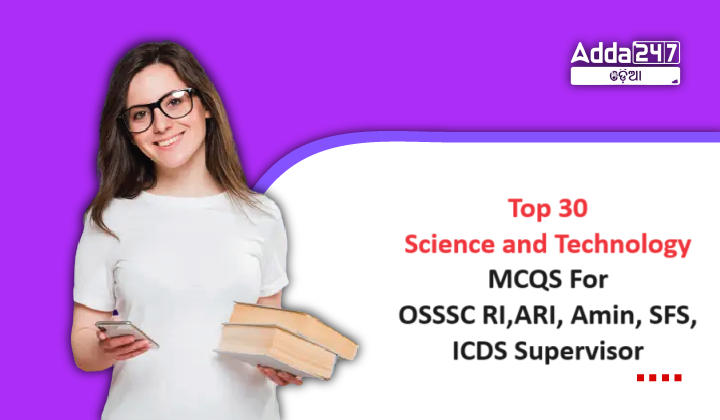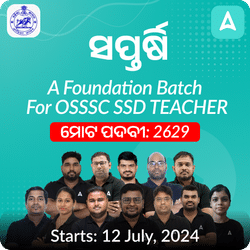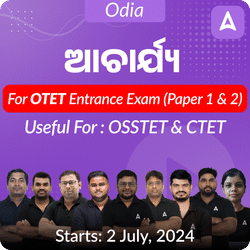Preparing for exams like OSSSC RI, ARI, Amin, SFS, ICDS Supervisor necessitates a thorough understanding of science and technology concepts. To aid in your preparation, here’s a selection of the top 30 multiple-choice questions (MCQs) covering various aspects of science and technology. These questions delve into topics ranging from basic scientific principles to cutting-edge technological advancements. By engaging with these MCQs, candidates can enhance their grasp of crucial scientific concepts and stay abreast of the latest developments in technology. Whether it’s understanding the fundamentals of physics, biology, chemistry, or exploring the latest innovations in the field of technology, these MCQs serve as valuable tools to assess and augment one’s knowledge base.
Top 30 Science and Technology MCQS For OSSSC RI,ARI, Amin, SFS, ICDS Supervisor
- What year was the Crime and Criminal Tracking Network Systems (CCTNS) launched?
(a) 2005
(b) 2007
(c) 2009
(d) 2011
Ans: (c) 2009 - Under which plan was CCTNS launched?
(a) National Development Plan (NDP)
(b) National e-Governance Plan (NeGP)
(c) National Cybersecurity Plan (NCP)
(d) National Policing Plan (NPP)
Ans: (b) National e-Governance Plan (NeGP) - Which ministry initiated the CCTNS project?
(a) Ministry of Information and Broadcasting
(b) Ministry of Defence
(c) Ministry of Home Affairs
(d) Ministry of Law and Justice
Ans: (c) Ministry of Home Affairs - What is one of the primary objectives of CCTNS?
(a) To increase tourism
(b) To create a comprehensive and integrated system for effective policing
(c) To manage traffic systems
(d) To improve education standards
Ans: (b) To create a comprehensive and integrated system for effective policing - Which principle does CCTNS aim to adopt for crime and criminal data?
(a) Multiple sources of truth
(b) Dual sources of truth
(c) Single source of truth
(d) Decentralized sources of truth
Ans: (c) Single source of truth - CCTNS facilitates the collection, storage, retrieval, analysis, transfer, and sharing of what type of data?
(a) Economic data
(b) Environmental data
(c) Crime and criminal data
(d) Educational data
Ans: (c) Crime and criminal data - What feature does CCTNS provide for authorized personnel?
(a) Real-time access to classified criminal data
(b) Free public access to all criminal records
(c) Anonymous data sharing
(d) Offline access to data
Ans: (a) Real-time access to classified criminal data - Which interface does CCTNS support for better accessibility?
(a) Mobile-based only
(b) Web-based only
(c) Both web-based and mobile-friendly
(d) Desktop-based only
Ans: (c) Both web-based and mobile-friendly - What is the role of the centralized database in CCTNS?
(a) It is only for archival purposes
(b) Accessible by state and national level law enforcement agencies
(c) It serves as a backup only
(d) Accessible by the general public
Ans: (b) Accessible by state and national level law enforcement agencies - How can citizens interact with CCTNS?
(a) By visiting police stations only
(b) Through an online interface to lodge complaints and check the status of their complaints
(c) By mailing their complaints
(d) By calling a helpline number
Ans: (b) Through an online interface to lodge complaints and check the status of their complaints - What recent modifications have been made to CCTNS?
(a) 10 modifications
(b) 15 modifications
(c) 23 modifications
(d) 30 modifications
Ans: (c) 23 modifications - Who launched the CCTNS project?
(a) Ministry of Finance
(b) Ministry of External Affairs
(c) Ministry of Home Affairs
(d) Ministry of Rural Development
Ans: (c) Ministry of Home Affairs - CCTNS is an initiative under which government plan?
(a) National Development Agenda
(b) Digital India Initiative
(c) National e-Governance Plan
(d) Smart City Project
Ans: (c) National e-Governance Plan - What year did CCTNS undergo significant modifications ahead of new criminal law implementations?
(a) 2020
(b) 2021
(c) 2022
(d) 2023
Ans: (d) 2023 - Which agencies provide the online interface for citizens in CCTNS?
(a) Private tech companies
(b) State and national law enforcement agencies
(c) Non-governmental organizations
(d) International policing bodies
Ans: (b) State and national law enforcement agencies - Where have scientists from the Physical Research Laboratory (PRL) in Ahmedabad discovered new craters on Mars?
(a) Olympus Mons region
(b) Tharsis volcanic region
(c) Valles Marineris
(d) Elysium Planitia
Ans. (b) Tharsis volcanic region - Which organization approved the naming of the new craters found on Mars?
(a) NASA
(b) ESA
(c) International Astronomical Union (IAU)
(d) SpaceX
Ans. (c) International Astronomical Union (IAU) - When was the International Astronomical Union (IAU) founded?
(a) 1919
(b) 1920
(c) 1930
(d) 1945
Ans. (a) 1919 - By how much did nitrous oxide emissions increase between 1980 and 2020?
(a) 20%
(b) 30%
(c) 40%
(d) 50%
Ans. (c) 40% - Which country is the largest emitter of nitrous oxide (N2O)?
(a) India
(b) China
(c) USA
(d) Brazil
Ans. (b) China - What percentage of nitrous oxide emissions in the past decade were due to agriculture?
(a) 50%
(b) 60%
(c) 70%
(d) 74%
Ans. (d) 74% - Which organization concluded the first phase of the ‘Phenome India’ Project?
(a) ICMR
(b) CSIR
(c) DRDO
(d) AIIMS
Ans. (b) CSIR - What is the primary focus of the ‘Phenome India’ Project?
(a) Infectious diseases
(b) Cardiovascular diseases
(c) Neurodegenerative diseases
(d) Cardio-metabolic diseases
Ans. (d) Cardio-metabolic diseases - Who recently urged the Election Commission to prioritize the counting of postal ballots?
(a) Ruling party
(b) Judiciary
(c) Media
(d) Opposition
Ans. (d) Opposition - Which category of voters is eligible for postal ballot voting?
(a) General voters
(b) Service voters
(c) Overseas voters
(d) All of the above
Ans. (b) Service voters - Where did scientists develop a novel method for generating non-infectious Nipah virus-like particles (VLPs)?
(a) IISc Bangalore
(b) Institute of Advanced Virology (IAV), Thiruvananthapuram
(c) IIT Delhi
(d) AIIMS
Ans. (b) Institute of Advanced Virology (IAV), Thiruvananthapuram - What is the primary use of Virus-like Particles (VLPs)?
(a) Diagnostic tools
(b) Vaccine development
(c) Therapeutic agents
(d) Gene therapy
Ans. (b) Vaccine development - What is the objective of China’s Chang’e-6 mission?
(a) Mars exploration
(b) Sample return from the far side of the moon
(c) Jupiter flyby
(d) Venus atmospheric study
Ans. (b) Sample return from the far side of the moon - Where did Chang’e-6 land on the moon?
(a) Mare Imbrium
(b) Sea of Tranquility
(c) South Pole-Aitken Basin
(d) Oceanus Procellarum
Ans. (c) South Pole-Aitken Basin - Recent scientific analysis has pushed back the origin of the Tamil-Brahmi script to which century BCE?
(a) 5th century BCE
(b) 6th century BCE
(c) 7th century BCE
(d) 8th century BCE
Ans. (c) 7th century BCE





